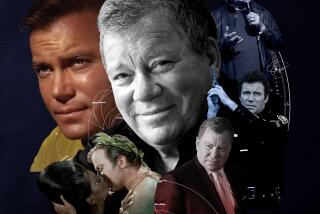Versatile Character Actor Edmond O’Brien, 69, Dies
- Share via
Oscar-winning character actor Edmond O’Brien, whose film roles ranged from introspective, beleaguered heroes to dynamic cops and private eyes, died after a years-long battle with Alzheimer’s disease, a spokesman said Thursday.
O’Brien, 69, who won an Academy Award for best supporting actor as a sweaty, fast-talking press agent in “The Barefoot Contesssa” in 1954, had been in poor health for several years and was diagnosed as having Alzheimer’s two years ago, according to his daughter, Maria O’Brien.
He died Wednesday night at St. Erne’s Sanatorium in Inglewood.
Hard-working and versatile, O’Brien is best known for his characterizations of Winston Smith, the mentally tortured protagonist of George Orwell’s “1984,” released in 1955, and of the alcoholic Southern senator imprisoned by the military in “Seven Days in May,” a 1964 feature about a nearly successful military coup in America. That role also won him an Oscar nomination.
He appeared in more than 60 films and television productions. In 1962 alone he worked in four: “The Man Who Shot Liberty Valance,” “Moon Pilot,” “Birdman of Alcatraz” and “The Longest Day.”
Born in New York, O’Brien got his first taste of acting at 16, carrying Lady Godiva’s bathtub across a stage in Westport, Conn. And a bitter taste it was: He staggered and fell into the tub.
Within a few years he was playing in summer stock and on Broadway. In the late 1930s he worked in radio and on stage with Orson Welles’ Mercury Theatre group. He was part of the famous 1938 radio broadcast based on H. G. Wells’ “The War of the Worlds” that caused panic among Americans who thought they were being invaded by Martians.
He had his first Hollywood role in 1939, when he was 24, in “The Hunchback of Notre Dame.” By the late ‘40s, after well-received performances in “White Heat,” “D.O.A.” and “The Killers”-- film noir productions that delved into the darker corners of everyday life--he was a star.
In 1949, a national poll by the Young Women’s League of America, a group devoted to single living, declared O’Brien to have more “male magnetism” than any other man in the country.
As he matured, his stocky, heavily jowled and essentially sympathetic features lent themselves to less sexy and more varied characters.
No ‘Personality Success’
“I’ve never made any kind of personality success,” he admitted in a 1963 interview. “People never say ‘that’s an Eddie O’Brien part.’ They say, ‘That’s a part Eddie O’Brien can play.’ ”
He prided himself on reading a play each day (“I read for fact and information; I find most novels overwritten because I’m so used to scripts”) and on being an actor who could do “a little more than just entertain.”
“I’d like to be able to say something important . . . to say something to people about their relationship with each other. If it touches just one guy, helps illustrate some points of view about living, then you’ve accomplished something.”
That drive was personified by a 1958 television drama that O’Brien directed and starred in. Written by his brother, Liam, “The Town That Slept With the Lights On” delved into the true story of two Lancaster murders that so frightened the community that residents began sleeping with their lights on.
O’Brien, who played a reporter sent into such a city to investigate, said he liked the script because it violated a basic law of television: “I’m not a private eye and I don’t solve the murders. TV is full of private eyes. Even the heroes of the Westerns are really private eyes on horseback solving crimes. But not here.”
Three Television Series
He starred in three 1960s television series, “Johnny Midnight,” “Sam Benedict” and “The Long Hot Summer” and directed several other TV episodes as well as two feature films: “Shield for Murder” in 1954 in collaboration with Howard W. Koch and “Mantrap” in 1961.
O’Brien suffered heart problems in 1971 and was not able to act after the mid-1970s because of a variety of ailments, his daughter said.
In a 1983 interview, Maria O’Brien quietly recalled the horror of seeing her father, a victim of Alzheimer’s--a degenerative brain disease--in a straitjacket at a Veterans’ Administration hospital.
“He was screaming. He was violent. I remember noticing how thin he’d gotten. We didn’t know, because for years he’d been sleeping with all his clothes on. We saw him a little later and he was walking around like all the other lost souls there.”
O’Brien was married twice, first briefly to actress Nancy Kelly in 1941 and then to another actress, Olga San Juan, in 1948. They were divorced in 1975 but remained close, according to his daughter.
O’Brien also is survived by another daughter, Bridget; a son, Brendan, a brother and two grandchildren.
Rosary will be recited at 7:30 p.m. today at St. Martin of Tours Church in Brentwood. Funeral Mass will be said at 1 p.m. Saturday at St. Martin of Tours, followed by interment at Holy Cross Cemetery in Culver City.
More to Read
Only good movies
Get the Indie Focus newsletter, Mark Olsen's weekly guide to the world of cinema.
You may occasionally receive promotional content from the Los Angeles Times.










